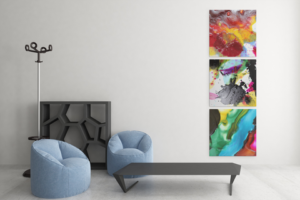Displaying art in the workplace can elevate employee performance, mood, and physical well-being, as well as bolster interpersonal bonds between employees and clients. Dozens of research studies conducted in the United States and Europe throughout the past 10 years have identified myriad ways — from the practical to the unconscious — that installing thoughtfully-chosen art in the workplace can improve employee experience and achievement, and help to communicate the right message to guests. In this brief guide, We summarize the many positive effects certain kinds of art can bring to employees and visitors, and share ideas about how to choose the best art for the workplace.
Art as a tool for wayfinding, culture, and employee ownership
Workplaces can often feel like a maze of desks, hallways, and doors. Because our brains hold onto memorable environmental features, art can usefully function as a landmark, helping people traveling through a space to remember where they’ve been. It can also come in handy when providing directions.
Amidst many options for addressing branding and company culture in the workplace, art can help communicate key brand messages in a non-verbal way. For example, an organization that displays unusual artwork is likely to be seen as conducting business in less traditional ways or marketing less conventional products; art that seems based in multiple ethnic traditions can signal multicultural management practices; and art depicting well-known and high-prestige locations, such as the White House, can indicate a history of working with powerful allies.
By this same token, if the art in place illustrates issues of common concern and collective identity — such as environmentally-responsible behavior or pediatric health — it can support a feeling of unity, whether among employees or between an organization and its clients. Additionally, while work environments can sometimes feel like universes unto themselves, art in the workplace can serve as an outlet for highlighting local culture and community, creating a bridge between the workplace and its surroundings. Successful corporate collections often feature local artists and demonstrate direct reference to the proximate cultural milieu.
For organizations hoping to give employees a sense of agency in their workplace environments, allowing workers to choose and position their own art can supply them a feeling of control, which has been linked to enhanced professional performance at the individual, group, and organizational levels. Participatory murals take this a step further, allowing employees to interact with the art post-installation and on their own terms. In general, employees show the most attention to detail, process and manage information best, and show the highest levels of organizational citizenship when their workplaces both display art and have allowed input into its selection and placement.
Art’s role in employee stress, health, and performance
Akin to its proven rehabilitative influence in hospitals, art in the workplace has also been shown to benefit employee well-being and performance. This is significant, as the office can easily become a place of stress and tension, and people become cognitively exhausted after prolonged periods of highly-focused work. Viewing artwork, particularly realistic nature scenes, helps workers restore mental energy and reduce stress. Unsurprisingly, both of these effects boost brain performance. Seeing nature images in artwork has also been linked to lower levels of anger in workplaces. One in four American workers report feeling chronically angry, which has been linked to negative outcomes such as retaliatory behavior, interpersonal aggression, poor work performance, absenteeism, and increased turnover. People who work in environments decorated with aesthetically-engaging art typically experience less stress and anger in response to task-related frustration, and thus help to build a more collaborative and enjoyable workplace.
Interpersonal interaction also results from art that sparks discussion among employees. If creativity, innovation, and open conversations are elements of an organization’s purported culture, the placement of engaging artwork can help substantiate these values and make them visually available. Employees tend to feel more cooperative and open to considering differing points of view when exposed to images they find pleasing, including images of places to which they feel a connection — for instance, an employee in New York City looking at a beautiful photo of Central Park, or an employee in London seeing a painting of the English countryside.
Art objects have also been shown to hold high emotional value for viewers, more than paintings, which are understood as extensions of their makers, representing a uniquely manifest, personal expression. Objets d’art — or, curated art objects — placed across the workplace is one technique for encouraging reflection and the resultant communal discussion, as well as instilling visual and material interest throughout the work environment at low cost. These can be deployed in large numbers and at multiple scales, and offer personality without preciousness or personal narrative.
If creativity, innovation, and open conversations are elements of an organization’s purported culture, the placement of engaging artwork can help substantiate these values and make them visually available.
Art, like nature, is significant in its ability to transport the viewer to a different mental plane — an experience often described as awe, or “experiencing perceptual vastness: the sense that one has come upon something immense in size, number, scope, ability, or social bearing.” When people experience awe, it can significantly lower levels of inflammation that can lead to chronic illnesses including diabetes, depression, and cardiovascular disease. It can also stimulate a more efficient processing of information, allowing people to feel less rushed, more patient, and more willing to volunteer. In healthcare settings, the display of nature scenes has been linked to lower levels of patients’ perceived pain, stress, anxiety, fatigue, and general distress, and is usually gauged to be a “positive distraction” (one that elicits good feelings and holds attention without causing stress, thereby blocking worrisome thoughts). Patients also socialize more with each other, are less restless and quieter when nature scenes are on view.

